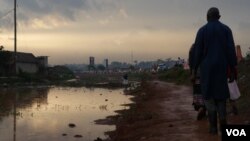East Africa is bracing for the impact of El Nino. In Uganda, the government is preparing for massive flooding and landslides and already dealing with a cholera outbreak. People living in slum areas are at particularly high risk.
El Nino, a global climate phenomenon that occurs when surface temperatures in the Pacific Ocean warm and redirect usual wind patterns, produces volatile weather patterns.
Godfrey Mujuni, a manager at Uganda's meteorological data center, said rains will continue through what should be the dry season.
“Of course, our analysis was based on the evolution of El Nino and we are still monitoring this El Nino because it has not decayed at all it is still there... if El Nino continues to be strong then we expect a somehow wet January and February, which are always dry months here in Uganda for us. In other areas, of course, El Nino is associated with warm and dry conditions, but here in East Africa, El Nino is associated with enhanced rainfall,” said Mujuni.
Heavy rains have already led to a cholera outbreak that has killed six people in western Uganda. And residents in rural mountainous areas prone to mudslides have been asked to vacate their homes. Large rain-induced mudslides in these areas in 2010 and 2012 left hundreds of people dead or missing.
In Kampala, a number of wetland systems around the city are responsible for drainage during periods of increased rainfall. However, both legal and illegal construction works have impeded the flow of water.
A recent report by the World Bank blames weak regulatory control for the deterioration of the wetlands, saying a lack of oversight has left Kampala's residents at risk. Peter Kaujju, a spokesman with The Kampala Capital City Authority (KCCA) said they are working to combat this problem.
“A major challenge still exists of people dumping in drainage channels, and at the end of the day they are clogged so there is no smooth flow of water. But we have carried out mass sensitization in these communities. We go to them, we share with them, we tell them what the repercussions are… These are some of the activities that stand in the way of storm water flow,” said Kaujju.
He said they have also razed some structures in wetland areas and along drainage channels.
Uganda has increased disaster management teams both in Kampala and around the country. Yet with rainfall expected to increase in the coming months, even preventative measures could leave some of the nation’s poorest residents with nowhere to go.





